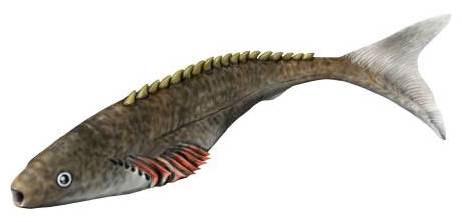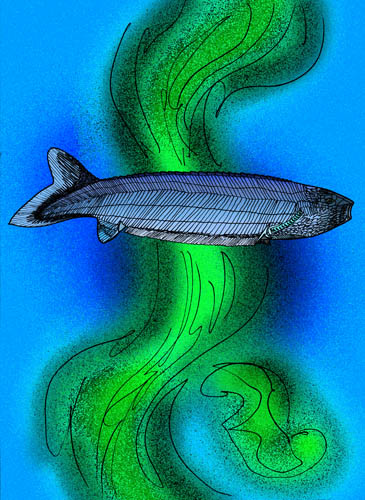|
Anaspidomorphi Genera
Anaspidomorphi (anaspidomorphs) is an extinct superclass of jawless fish. According to the newer taxonomy based on the work of Nelson, Grande and Wilson 2016 and van der Laan 2018, the phylogeny of Anaspidomorphi looks like this: * Superclass †Anaspidomorphi ** Order † Euphanerida *** Family † Euphaneropidae Woodward, 1900 ** Order †Jamoytiiformes Halstead-Tarlo, 1967 *** Family † Achanarellidae Newman, 2002 *** Family † Jamoytiidae White, 1946 ** Class †Anaspida Anaspida ("shieldless ones") is an extinct group of jawless fish that existed from the early Silurian period to the late Devonian period. They were classically regarded as the ancestors of lampreys, but it is denied in recent phylogenetic anal ... Janvier, 1996 non Williston, 1917 *** Order † Endeiolepidiformes Berg, 1940 **** Family † Endeiolepididae Stensio, 1939 *** Order † Birkeniiformes Stensiö, 1964 **** Family † Pharyngolepididae Kiær, 1924 **** Family † Pterygolepididae Obručhev, 1 ... [...More Info...] [...Related Items...] OR: [Wikipedia] [Google] [Baidu] |
Birkeniiformes
Anaspida ("shieldless ones") is an extinct group of jawless fish that existed from the early Silurian period to the late Devonian period. They were classically regarded as the ancestors of lampreys, but it is denied in recent phylogenetic analysis, although some analysis show these group would be at least related. Anaspids were small marine fish that lacked a heavy bony shield and paired fins, but were distinctively hypocercal. Anatomy Compared to many other ostracoderms, such as the Heterostraci and Osteostraci, anaspids did not possess a bony shield or armor, hence their name. The anaspid head and body are instead covered in an array of small, weakly mineralized scales, with a row of massive scutes running down the back, and, at least confirmed among the birkeniids, the body was covered in rows of tile-like scales made of aspidine, an acellular bony tissue. Anaspids all had prominent, laterally placed eyes with no sclerotic ring, with the gills opened as a row of holes along ... [...More Info...] [...Related Items...] OR: [Wikipedia] [Google] [Baidu] |
Birkeniidae
Birkeniidae is an extinct family of jawless fish belonging to the order Birkeniiformes Anaspida ("shieldless ones") is an extinct group of jawless fish that existed from the early Silurian period to the late Devonian period. They were classically regarded as the ancestors of lampreys, but it is denied in recent phylogenetic analy .... They were defined in 1899 by Ramsay H. Traquair, and were a successful family among the many jawless fish in the Silurian seas. Morphology Birkeniidae had a large body which was ovular in shape, and a strong, mobile tail. Their eyes were positioned on either side of the head. Their mouth was large for the jawless fish, but contained no teeth. Birkeniidae are distinguished by the crown shaped projection on their back, and the other smaller projections which run down its tail. They also possessed fins which faced downwards, an uncommon trait among the jawless fish. They had typical scaly skin. References External links * Birkeniifor ... [...More Info...] [...Related Items...] OR: [Wikipedia] [Google] [Baidu] |
Ramsaasalepididae
''Ramsaasalepis'' is an extinct genus of jawless fish. It is the type and the only known genus of the family Ramsaasalepididae, one of many families of prehistoric jawless fish, and contains the single species ''Ramsaasalepis porosa''. It was described based on a number of fossilized, disarticulated thelodont scales that may have had a ridged texture. The species had a well-developed vascular canal system. Based on these characteristics and its stratigraphical range, is speculated to be most closely related to the genera '' Septentrionia'' and '' Tahulalepis''. ''Ramsaasalepis'' lived during the Silurian period. Competition with recently evolved jawed fish has been suggested as a reason for the extinction of this and many other jawless fish species. It probably was a filter feeder Filter feeders are aquatic animals that acquire nutrients by feeding on organic matters, food particles or smaller organisms (bacteria, microalgae and zooplanktons) suspended in water, t ... [...More Info...] [...Related Items...] OR: [Wikipedia] [Google] [Baidu] |
Lasaniidae
''Lasanius'' is a genus of basal jawless fish from the Early Silurian, around 443.8 million years ago, known from fossils found near Lesmahagow, Scotland. Specimens range from 13.3 to 74.5 mm in length. ''Lasianus'' has a pair of eyes, and a notochord, and while it has rows of bony scutes running along its back, it lacks the armour typical of other Paleozoic jawless fish like ostracoderms. There are also structures close to the front of the animal dubbed "chains" and "rods", of unclear function. At the end of the body a hypocercal tail fin was present in the form of a caudal lobe. Historically, it has often been allied with the anaspids, though other studies found it to be unrelated. A comprehensive redescription published in 2023 found that it was a stem-group cyclostome, more closely related to hagfish and lampreys than to jawed fish Gnathostomata (; from Ancient Greek: (') 'jaw' + (') 'mouth') are jawed vertebrates. Gnathostome diversity comprises roughly 60,000 spe ... [...More Info...] [...Related Items...] OR: [Wikipedia] [Google] [Baidu] |
Tahulalepididae
Anaspida ("shieldless ones") is an extinct group of jawless fish that existed from the early Silurian period to the late Devonian period. They were classically regarded as the ancestors of lampreys, but it is denied in recent phylogenetic analysis, although some analysis show these group would be at least related. Anaspids were small marine fish that lacked a heavy bony shield and paired fins, but were distinctively hypocercal. Anatomy Compared to many other ostracoderms, such as the Heterostraci and Osteostraci, anaspids did not possess a bony shield or armor, hence their name. The anaspid head and body are instead covered in an array of small, weakly mineralized scales, with a row of massive scutes running down the back, and, at least confirmed among the birkeniids, the body was covered in rows of tile-like scales made of aspidine, an acellular bony tissue. Anaspids all had prominent, laterally placed eyes with no sclerotic ring, with the gills opened as a row of holes along ... [...More Info...] [...Related Items...] OR: [Wikipedia] [Google] [Baidu] |
Rhyncholepididae
''Rhyncholepis'' was an extinct genus of anaspid from the Late Silurian. Fossils of species ''R. butriangula'' and ''R. parvula'' have been found in Ringerike, Norway, and Oesel, Estonia. The genus Genus (; : genera ) is a taxonomic rank above species and below family (taxonomy), family as used in the biological classification of extant taxon, living and fossil organisms as well as Virus classification#ICTV classification, viruses. In bino ... has two species, described in 1911 and 2002. Discovery ''Rhyncholepis parvula'' was discovered and originally described in 1911, and described in more detail in 1924 by Norwegian Professor Johan Kiær. In the associated monograph, Kiær describes the genus in great detail, along with several other anaspids discovered around the same time. More recently, the second discovered species (''R. butriangula'') was described by Henning Blom, Tiiu Märss, and C. Giles Miller in 2002. References Birkeniiformes Silurian jawless fish ... [...More Info...] [...Related Items...] OR: [Wikipedia] [Google] [Baidu] |
Pterygolepididae
''Pterygolepis'' is an extinct genus of jawless fish belonging to the order Birkeniiformes Anaspida ("shieldless ones") is an extinct group of jawless fish that existed from the early Silurian period to the late Devonian period. They were classically regarded as the ancestors of lampreys, but it is denied in recent phylogenetic analy .... File:Pterygolepis nitidus Tuebingen.jpg, Fossil of ''Pterygolepis nitidus'', an extinct fish. Took the picture at Museum of Paleontology, Tübingen File:Pterygolepis.jpeg, ''Pterygolepis nitidus'' from Lower Silurian of Norway References External links * Birkeniiformes Silurian fish of Europe Silurian jawless fish Fossil taxa described in 1920 Birkeniiformes genera {{paleo-jawless-fish-stub ... [...More Info...] [...Related Items...] OR: [Wikipedia] [Google] [Baidu] |
Pharyngolepididae
''Pharyngolepis'' is an extinct genus of primitive jawless fish that lived in the Silurian period of what is now Norway. ''Pharyngolepis'' had well-developed anal and caudal fins, but no paired or dorsal fins that would have helped stabilise it in the water, and so was probably a poor swimmer, remaining close to the sea bottom. The pectoral fin Fins are moving appendages protruding from the body of fish that interact with water to generate thrust and help the fish aquatic locomotion, swim. Apart from the tail or caudal fin, fish fins have no direct connection with the vertebral column ...s were instead replaced by bony spines, possibly for protection against predators, and there was a row of spines along the back. It probably scooped up food from the ocean floor. References Birkeniiformes Silurian fish of Europe Fossil taxa described in 1911 Birkeniiformes genera {{Paleo-jawless-fish-stub ... [...More Info...] [...Related Items...] OR: [Wikipedia] [Google] [Baidu] |
Endeiolepididae
Euphaneropidae is an extinct family of prehistoric jawless fishes in the extinct order Euphanerida. These fishes are characterised by a greatly elongated branchial apparatus which covers most of the length of the body. Fossils are known from the Lower Silurian and Middle Devonian of Scotland, and the Upper Devonian of Canada. In particular, ''Euphanerops'' is unique in that it has two anal fins. References * Super-Class Agnatha. T. Jeffery Parker and William A. Haswell, Textbook of Zoology Vertebrates pp 164–202 External links * * Anaspidomorphi Prehistoric jawless fish families {{paleo-jawless-fish-stub ... [...More Info...] [...Related Items...] OR: [Wikipedia] [Google] [Baidu] |
Late Devonian
The Devonian ( ) is a geologic period and system of the Paleozoic era during the Phanerozoic eon, spanning 60.3 million years from the end of the preceding Silurian period at million years ago ( Ma), to the beginning of the succeeding Carboniferous period at Ma. It is the fourth period of both the Paleozoic and the Phanerozoic. It is named after Devon, South West England, where rocks from this period were first studied. The first significant evolutionary radiation of life on land occurred during the Devonian, as free- sporing land plants (pteridophytes) began to spread across dry land, forming extensive coal forests which covered the continents. By the middle of the Devonian, several groups of vascular plants had evolved leaves and true roots, and by the end of the period the first seed-bearing plants ( pteridospermatophytes) appeared. This rapid evolution and colonization process, which had begun during the Silurian, is known as the Silurian-Devonian Terrestrial Rev ... [...More Info...] [...Related Items...] OR: [Wikipedia] [Google] [Baidu] |


